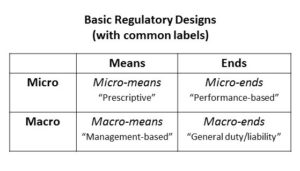
New National Academies of Sciences report offers much-needed clarity about regulatory design decisions.
Governments have long regulated the safety of industries engaged in hazardous activities. Safety regulation aims to ensure that industries can continue to provide their vital goods and services but without imposing undue risk of harm to workers, the public, and the environment. How can regulatory officials best design their regulations to achieve these aims?
Various regulatory designs offer different advantages and disadvantages, depending on the circumstances under which they are applied. To make smart decisions, regulators need a clear conceptual framework about their design options and about the conditions under which different designs will work best. Such a framework can be found in a new report issued under the auspices of the National Academies of Sciences, Engineering, and Medicine.
The U.S. Pipeline and Hazardous Materials Safety Administration asked the National Academies to convene a committee to examine key factors that are relevant to government safety regulators as they choose among regulatory designs, particularly for preventing low-frequency, high consequence events. These safety regulations are often scrutinized after an incident occurs, but even then their effectiveness can be inherently difficult to assess when their main purpose is to reduce catastrophic failures that are rare to begin with. Nevertheless, although safety regulation cannot prevent all harmful incidents, regulators need to have confidence that the regulatory designs they choose are well suited to the particular circumstances in which those designs are applied. Regulators must also be able to provide a reasoned basis for their choices to policy makers and the public.
Regulators can design their regulations in several ways. One distinction focuses on the point at which the regulation intervenes in a causal chain that leads to the ultimate catastrophic risk. For example, regulations can target at a micro-level by imposing requirements on firms to mitigate specific contributors to risks. Or they can regulate at a more macro–level by focusing their requirements less on individual risk contributors and more on mitigating overall risk.
In addition to having a micro- or a macro-level emphasis, regulations can also be designed to specify the means that firms must use or the ends they must achieve.
 To provide much-needed conceptual clarity over regulatory design choices, the National Academies’ committee focused on the salient design features that follow from the macro-micro and means-ends distinctions. These features suggest four basic regulatory design types: micro-means, micro-ends, macro-means, and macro-ends.
To provide much-needed conceptual clarity over regulatory design choices, the National Academies’ committee focused on the salient design features that follow from the macro-micro and means-ends distinctions. These features suggest four basic regulatory design types: micro-means, micro-ends, macro-means, and macro-ends.
The impetus for the committee’s report, one that suffuses the debate about how best to regulate high-hazard industries, is growing interest in macro-means regulations—that is, regulations that require firms to establish management systems to identify, prioritize, and mitigate their safety risks.
Often contrasted with “prescriptive” or micro-means regulations, and sometimes mislabeled as “performance-based,” management regulations are more aptly described as having a macro-means design. They require firms to address overall risk—that is, at a macro-level—by using the specified means of a management system. Under this regulatory design, firms are required to develop internal plans and manage organizational- and system-level processes that focus managers’ attention on catastrophic risk. Notably, these management regulations do not require firms to achieve specified ends, or performance outcomes, such as a demonstrable reduction in the risk of major incidents. Such an outcome would be particularly difficult to demonstrate when regulations are intended to prevent catastrophic failures, given their complexity and rare occurrence.
Informed by academic research as well as by insights from case studies of the regulatory regimes of four countries governing two high-hazard industries, the committee’s report concludes that macro-means regulations can serve a valuable purpose by addressing risks that are complex and context-specific, as is characteristic of low-frequency, high-consequence events. How well these regulations serve this purpose, however, will depend on a number of factors, including the details of how the regulation is structured, the capabilities of the regulator in supporting and motivating compliance, and the capacity of the regulated firms to plan, assess, and act in ways that fulfill the purpose of the regulation.
Any decision to use macro-means regulation must consider the regulator’s own ability to enforce and motivate compliance through methods such as auditing and field inspections. It should also take into account the capacity of regulated entities to meet their obligations. If these preconditions are missing or cannot be created, regulators should be concerned that this management style of regulation will be less effective than desired.
Unfortunately, for many years regulatory professionals have placed too much emphasis on ambiguous and often misleading labels such as “performance-based” and “prescriptive,” and they have gravitated toward simplistic lists of generic advantages and disadvantages of regulatory design types. Only by clarifying design concepts and explaining how specific circumstances can affect each design’s advantages and disadvantages can regulators of high-hazard industries make more informed and better articulated regulatory choices.
Coglianese served as a member of, and Menzies as the staff director to, the National Academies’ committee on performance-based safety regulation that issued the report described in this essay.





